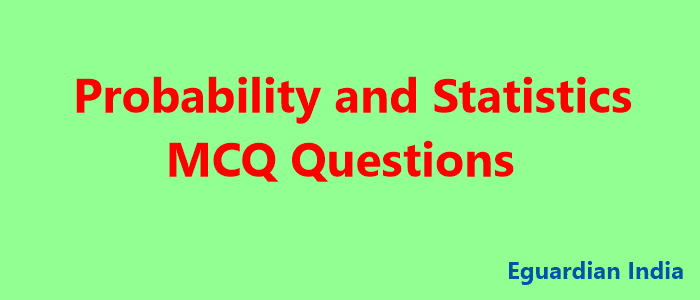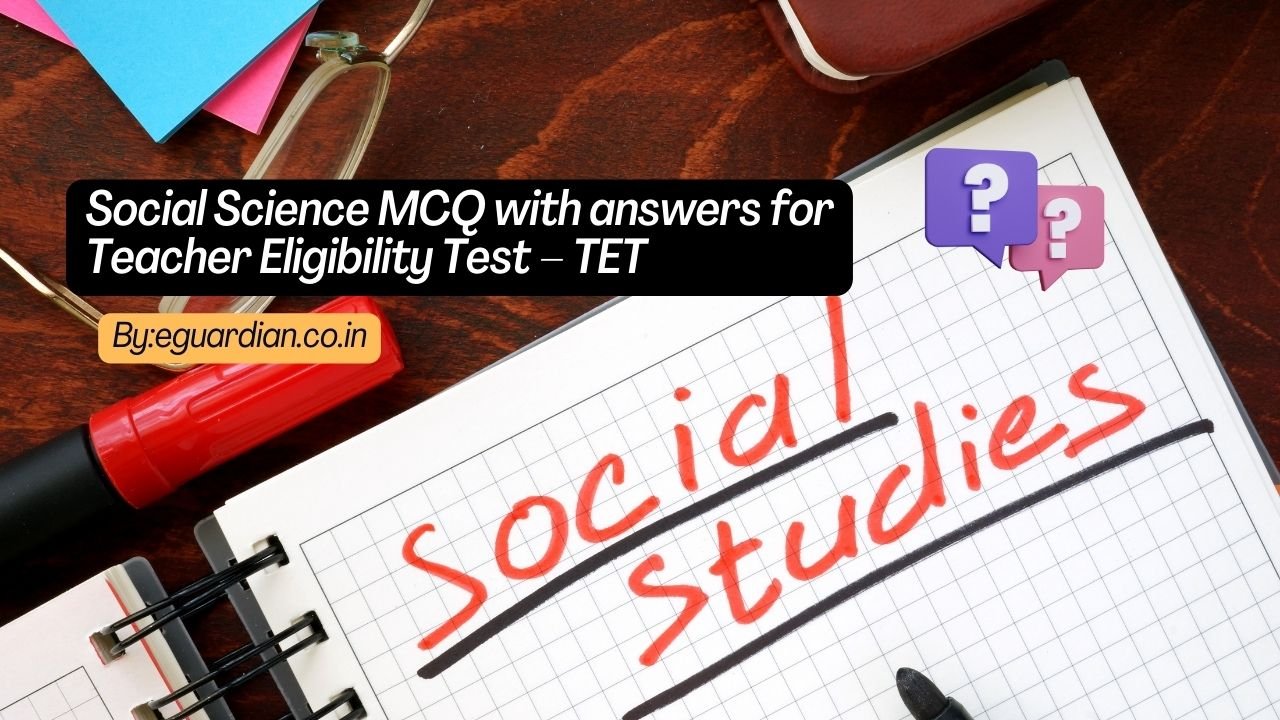Probability and Statistics MCQ Questions with answer keys for preparation of academic and competitive exams of various institutions in 2025
Q1. If P(A) = 0.35, P(B) = 0.73, P(A∩B) = 0.14, find P(A U B)
Ans. 0.86
Q2. When two dice are tossed, what is the probability of getting four as the sum of the face numbers?
Ans. 1/12
Q3: If A and B are independent and P (A) = 1/3 P(B) = 1/4, find P(A∩B)
Ans. 1/12
Q4. A coin is tossed thrice. What is the chance of getting all heads?
Ans. 1/8
Q5: If P(A) = 0.9, P(B/A) = 0.8, find P(A ÇB)
Ans. 0.72
Q6: If P(A) = 1/3, P(B) = 3/4 , find (P È B) = 11/12, find P(A/B) and P(B/A)
Ans. 2/9, 1/2
Q7: There are 3 true coins and 1 false coin with ‘head’ on both sides. A coin is chosen at random and tossed 4 times. If ‘Head’ occurs all the 4 times. If the head occurs at all the 4 times, what is the probability that the false coin has chosen and used?
Ans. 16/19
Q8: A random variable X has the following probability function
| x | 0 | 1 | 2 | 3 | 4 |
| P(X=x) | c | 3c | 5c | 7c | 9c |
i) Find the value of c.(ii) Find P(X<4), P(X>4), P(0<X<4)
ii) Find the distribution function of X.
Ans. c = 1/25 and 16/25, 9/25, 3/5
Q9: The joint distribution of X and Y is given by
F(x,y) = x+y / 21, x = 1,2,3; y = 1,2 Find the marginal distributions.
Ans. 5/21, 7/21, 9/21, and 9/21, 12/21,
Q10: Two coins are thrown simultaneously and let X denotes the number of heads. Calculate all possible outcomes and find the probability distribution of X. Also calculate the expected values of X.
Ans. Let H denotes the head and T denotes the tail. So all possible outcomes after tossing two coins simultaneously are
Outcomes Number of heads Probability of occurrence
HH 2 2/4 = ½
HT 1 1/4
TH 1 1/4
TT 0 0
So, E(X) = 0.f(x) + 1.f(x) + 2.f(x) = 1. 2/4 + 2. ½ = 3/2
Q11: Let pmf of discrete random variable is p(x) = 1/n, where x = 1,2,3,4,….. Find E(X).
Ans. (n+1)/2
Q12: By throwing a fair die, a game is played. A player wins Rs. 20 if 2 turns up, Rs. 40 if 4 turns up and loses Rs.30 if 6 turns up. And he never loses or gains if any other number turns up. Find the expected value of money won.
Ans. E(X)=5
Q13: X is a random variable whose density function is
Q14: Find the mean of the random variable X, if its pdf is given by
f(x)= 6x(1-x), 0≤x≤1.
Ans. E(X)=1/2
Q15: If the joint pdf of (X,Y) is given by f(x,y)= 24y(1-x), 0≤y≤x≤1, find E(XY).
Ans. E(XY)=4/15
Q16: Assume two random variables X and Y jointly distributed with density function f(x,y)= x+y¸ 0≤x≤1, 0≤y≤1. Find Cov(X,Y).
Ans. -1/144.
Q17. Two events A and B are independent if and only if P(AUB) is equal to which among the following?
a. P(A) U P(B)
b. P(A)*P(B)
c. P(A) ∩ P(B)
d. P(A ∩ B)
Q18. Two or more events are independent if the occurrence of one ____ the occurrence of the other.
a. is the same as the
b. depends on
c. does not affect the
d. differs from the
Q19. All possible outcomes of an experiment are called which among the following?
a. mutually independent events
b. mutually exclusive events
c. independent events
d. exhaustive events
Q20. If f is a function (mapping) from S into the set R of all real numbers and X = f(s), sϵS, then which among the following holds?
a. X is an independent variable
b. X is called a random variable on S
c. S is called a random variable on S
d. S is an independent variable
Q21. Which is not a possible outcome of tossing 3 coins together?
a. HHTT
b. HTHH
c. TTTT
d. All of these
Q22. If (X, Y) is a two-dimensional random variable, and if X & Y are independent then V(X+Y)
a. V(X) + V(Y)
b. V(X) – V(Y)
c. V(X)*V(Y)
d. [V(X)+V(Y)] / sqrt[{V(X)*V(Y)}]
Q23. The measure of association between two random variables is called which of the following?
a. convergence
b. covariance
c. conditional variance
d. conditional expectation
Q24. If X and Y are independent random variables, then E(XY) is equal to which of the following?
a. E(X)+E(Y)
b. E(X)*E(Y)
c. [E(X)+E(Y)] / sqrt[{E(X)*E(Y)}]
d. [E(X)-E(Y)] / sqrt[{E(X)*E(Y)}]
Q25. The moment generating function of the sum of a number of the independent random variable is ____ the product of their respective moment generating functions.
a. greater than or equal to
b. lesser than
c. equal to
d. lesser than or equal to
Q26. Which of the following is Not among the requisites of a good average?
a. should be based on all values
b. should be easy to calculate
c. should be affected by sampling fluctuation
d. should have sampling stability
Q27. Which of the following does not fall among the category of averages?
a. Mathematical Average
b. Harmonic Average
c. Positional Average
d. Miscellaneous Averages
Q28. Which of the following method cannot be used to find the arithmetic mean for individual series?
a. Indirect method
b. Direct method
c. Step deviation method
d. Short cut method
Q29. The geometric mean is ___ than the arithmetic mean.
a. always larger
b. never larger
c. always lesser
d. never lesser
Q30. The total number of items of a value divided by the sum of reciprocal of values of the variable is known as which of the following?
a. Harmonic mean
b. Deciles
c. Median
d. Weighted Arithmetic average
Q31. The most commonly used measure of central tendency is which of the following?
a. Step deviation method
b. Arithmetic average
c. Harmonic Mean
d. Geometric mean
Q32. The value which occurs with the maximum frequency is called ____.
a. Cumulative frequency
b. Quartile
c. Mode
d. Median
Q33. The absolute measure of variation does not include which of the following?
a. Standard Deviations
b. Range
c. Quartile Deviations
d. Median deviation
Q34. Which among the following is the simplest method of studying variations?
a. Limits
b. Dispersion
c. Range
d. Deviation
Q35. Quartile divides the total frequency into how many equal parts?
a. Two
b. Three
c. Four
d. Five
Q36. Which of the following term is Not used to describe standard deviation?
a. mean square error deviation
b. Mean error deviation
c. Variation
d. Root mean square deviation
Q37. Which of the following is Not among the properties of standard deviation?
a. is always lesser than zero
b. It is independent of origin
c. is the least of all RMS Deviations
d. It is not independent of scale
Q38. Which of the following is the requirement of Bernoulli Trials?
a. The probability of the outcome is random
b. Each trial has more than 2 outcomes
c. all the trials are mutually dependent
d. all the trials are statistically independent
Q39. Which of the following conditions is invalid regarding Binomial Random Variable?
a. Trails must be Bernoulli trails
b. The outcome should be a success or failure
c. The outcome must be dependent
d. The probability of success must be constant
Q40. The standard normal distribution is the Normal distribution for which the mean is ___ and the variance is 1.
a. Zero
b. One
c. Constant
d. Random variable
Q41. Which among the following is not a type of correlation?
a. Simple correlation
b. complex correlation
c. Linear correlation
d. Non-linear Correlation
Q42. Two variables are said to be ___ correlated when both the variables under study move in the same direction.
a. linearly
b. negatively
c. positively
d. perfectly
Q43. When both the variables change at a constant rate irrespective of the change in direction, then it is called ___ correlation.
a. non-linear
b. simple
c. partial
d. perfect
Q44. Which of the following is NOT among the methods used to find the measurement of correlation?
a. Scatter Diagram method
b. Karl Pearson’s Coefficient method
c. Pearson’s rank method
d. Spearman’s Rank Coefficient method
Q45. The measure of the average relationship between two or more variables in terms of the original units of the data is called which of the following?
a. deviation
b. regression
c. variation
d. dispersion
Q46. Multiple regression analysis can be used to find which of the following?
a. the estimates of the dependent variable from values of independent variables
b. To obtain the measure of the error involved
c. To obtain a measure of the proportion of variance
d. all the above
Q47. Which of the following is not among the types of index numbers?
a. Price index number
b. Value Index Number
c. Weighted Index number
d. Quality Index number
Q48. Which of the following is not among the types of weighted aggregate method?
a. Laspeyre’s method
b. Relative method
c. Fisher’s method
d. Walsch’s method
Q49. Fisher’s Ideal Method index number is the geometric mean of the Laspeyre and ___ method.
a. Dorbish
b. Bowley’s
c. Paasche’s
d. Kelly’s
Q50. The consistency and adequacy of an index number formula CANNOT be verified by which of the following?
a. Order reversal test
b. Factor reversal test
c. Time reversal test
d. Index reversal test
Software Testing and Quality Assurance with Answers pdf
Conclusion Points
While we can’t provide a full list of MCQs with answer keys in this response, we can definitely help you on your way to finding some great practice problems for Probability and Statistics!
Here are some tips for finding high-quality, up-to-date MCQ resources:
1. Textbooks: Statistics and Probability textbooks often have practice question sections at the end of each chapter. Look for recent editions to ensure the content is current.
2. Online Resources: Many websites offer free or paid access to practice questions. Reputable educational sites like testbook.com, sanfoundry.com, etc. often have sections dedicated to Probability and Statistics with practice problems.
3. Educational Blogs: Blogs from statistics professors or data science instructors may have compilations of practice MCQs. Look for sites with a recent posting history to increase the chance of finding current content.
Remember, consistent practice is key to mastering Probability and Statistics. By working through a variety of problems, you’ll solidify your understanding of the concepts and approaches needed to succeed.




WONDERFUL Post.thanks for share..more wait .. ?